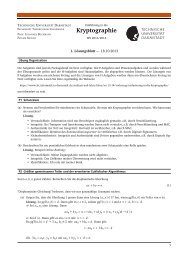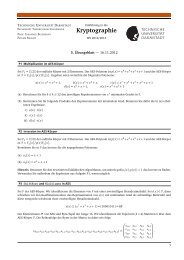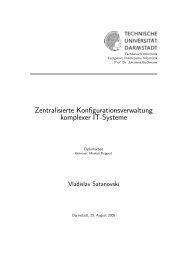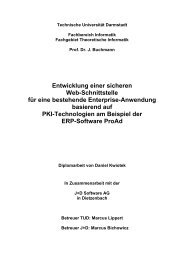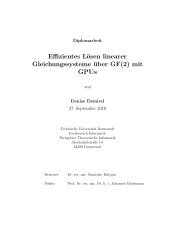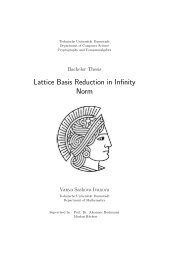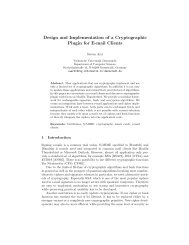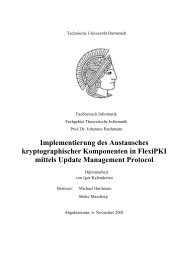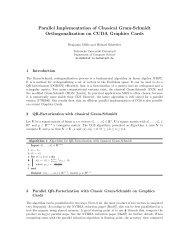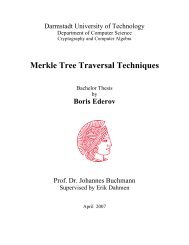An efficient mobile PACE implementation - CDC
An efficient mobile PACE implementation - CDC
An efficient mobile PACE implementation - CDC
You also want an ePaper? Increase the reach of your titles
YUMPU automatically turns print PDFs into web optimized ePapers that Google loves.
Variant State 1 [ms] State 2 [ms]<br />
α 7580 6280<br />
β 9<br />
7330 6310<br />
γ 7530 6360<br />
δ 9034 7775<br />
Table 11: Optimized <strong>PACE</strong> performance tests on Nokia 6212<br />
two columns. The first state can’t make use of any stored values<br />
(precomputed points or domain parameters). The second one uses<br />
the stored values to precalculate the result of Equation (1). In variant<br />
δ Equation (10) also uses these stored values. The rows show<br />
the four different possibilities of rearranging the equations as presented<br />
in Section 4.1. Except variant δ, the results are very similar<br />
so that the fastest variant may vary depending on the used hardware<br />
and operating system. Although variant δ does not perform as well<br />
as the others on the our device, it has some promising approaches<br />
and might be of use in future generations of <strong>mobile</strong> devices.<br />
6. POTENTIAL SIDE CHANNEL VUL-<br />
NERABILITIES OF <strong>PACE</strong><br />
Elliptic curve operations are known to be vulnerable to side<br />
channel attacks if no appropriate countermeasures are taken. The<br />
basic problems are power analysis attacks [25] and timing attacks<br />
[24]. In this section, we briefly address the side channel security issues<br />
of the <strong>PACE</strong> protocol on the side of the PCD given Algorithms<br />
2 and 1 are used. First, we identify potential targets of such attacks<br />
against the elliptic curve algorithms.<br />
There are three scalar values that are used for point multiplication<br />
in one run of the <strong>PACE</strong> protocol: x, s, and � SKPICC. All of<br />
these values are ephemeral, thus only a single protocol run is available<br />
to an attacker to recover these values. If an attacker aims at<br />
gaining the encryption and MAC keys derived in the course of the<br />
protocol, he has to find all three scalar values. While s is only used<br />
in one scalar multiplication, the other two are used in two scalar<br />
multiplications each. Since differential analysis are based on far<br />
more recordings than this, only simple analysis can be used to recover<br />
these values.<br />
This basically rules out timing attacks, since they demand differential<br />
analysis by nature. One exception is an attack recovering<br />
the hamming weight of the scalar against an unprotected binary<br />
method: here the running time is linearly dependent on the hamming<br />
weight of the scalar. However, the hamming weight will in<br />
general not suffice to enable actual recovery of the secret scalar<br />
values.<br />
Concerning power analysis attacks, it should be pointed out that<br />
a scenario, where the attacker has actual access to CPU’s power<br />
supply is not realistic. However, electro-magnetic radiation (EM)<br />
attacks [1] are similar in nature. Thus, it seems advisable to include<br />
power analysis countermeasures in order to prevent EM attacks.<br />
Note that in the case of a binary method for the elliptic curve scalar<br />
multiplication, even simple EM analysis, i.e. an attack based on<br />
a single recorded trace, is feasible. If the attacker can distinguish<br />
the doubling and the addition operation, he can read the bits of the<br />
secret scalar from the trace.<br />
It is important not only to address the scalar multiplication, but<br />
also the exponent recoding operations that are necessary when ap-<br />
9 As no available <strong>mobile</strong> Java CSP supports this directly, x1, x2,<br />
Y1 and Y2 are generated in a preparation step and then passed to<br />
a standard interleaving multiplication method together with s, G,<br />
and Y .<br />
plying NAF representations. Such an attack is presented in [32].<br />
The symmetric operations involving secrets have to be secured<br />
as well. Specifically, the derivation of the cipher key Kπ and the<br />
decryption in step 2 of algorithm 2 must be secure against differential<br />
analysis, since they involve the same secret values whenever<br />
a specific eID is used. The MAC and encryption operations performed<br />
using KMAC and KENC after the <strong>PACE</strong> protocol also need<br />
to be secure with respect to differential analysis to a certain extend,<br />
since they will be used for a complete session.<br />
7. FUTURE WORK<br />
The differentiation between the two states of the optimized<br />
<strong>PACE</strong> protocol is only necessary due to the fact that the Nokia<br />
6212 only recognizes the eID card when it is lying on the top of<br />
the cellphone. The reason for this is the location of the antenna<br />
and its field intensity. Most likely newer devices don’t have these<br />
disadvantages. Thus, it would be possible for the user to enter the<br />
PIN while the eID card has contact to the <strong>mobile</strong> phone. Then the<br />
phone would be able to decide whether it knows the eID card or<br />
not and load the necessary domain parameters to run Algorithm 1.<br />
Thereby the runtimes for the two states would be equal so that the<br />
differentiation between the two states becomes obsolete.<br />
The <strong>mobile</strong> device could, besides saving the base point and its<br />
multiples for Lim-Lee, also save multiples of that point generated<br />
during the evaluation of Equation (1) for further use. This clearly<br />
would save computation time. However, the available <strong>mobile</strong> cryptographic<br />
libraries do not offer the possibility to use the stored<br />
points. Thus, this optimization is left for future work including respective<br />
modifications of the applied cryptographic library. Saving<br />
precomputed values for the w-NAF multiplication is also possible<br />
but does not lead to significant performance improvements since<br />
the computation for a window size of 5 only includes 3 ADD and 1<br />
DBL, which is negligible.<br />
The method used for the second variant in Section 4.1 can be<br />
generalized to a method for various ei, Pi pairs with different sizes<br />
of the ei. We call this Interleaved-Lim-Lee-Combining (ILLC).<br />
Here, each ei, Pi pair where the scalar exceeds the determined size<br />
is broken into ej, Pj pairs with the correct scalar size. For each<br />
ei, Pi pair where the scalar ei is smaller than the determined size<br />
the scalar ei is padded to the correct size. To our knowledge none<br />
of the available cryptographic libraries offer this method, it seems<br />
not even to exist in literature. Hence, we will investigate and implement<br />
ILLC ourselves.<br />
There are more possible optimizations which we did not apply,<br />
as no available <strong>mobile</strong> provider supported their <strong>implementation</strong>.<br />
Examples involve using Montgomery Multiplication [28], <strong>efficient</strong><br />
point triplication [5] and quintuplication [27]. While we limited<br />
ourselves in the work at hand to <strong>PACE</strong> optimizations realizable<br />
without modifications to existing <strong>mobile</strong> providers, the next round<br />
of <strong>PACE</strong> optimizations will include all mentioned methods which<br />
require such modifications.<br />
<strong>An</strong>other, rather adventurous optimization deliberately violates<br />
the <strong>PACE</strong> protocol. Instead of choosing x and � SKPCD uniformly<br />
at random, the PCD could set x = s and � SKPCD ≡ s −1 mod r,<br />
where r is the order of the used elliptic curve. By this, computing<br />
�P KPCD is reduced to compute G + Y which annihilates 2 random<br />
number generations and 2 MULT. Unfortunately, this allows<br />
an attacker eavesdropping on the communication to reconstruct the<br />
PIN. It is sufficient to once eavesdrop on a tuple D, z, X sent by<br />
the PCD. The attacker then can systematically try each possible<br />
PIN to decrypt z and verify it by checking whether X = s · G<br />
holds. Hence, this optimization is not suitable for the eID card sce-





